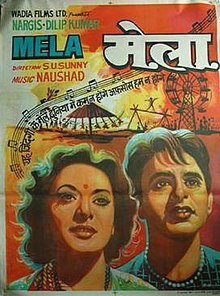1948 Bombay, India
Zaitoon Shaikh
1942
Bombay, India
Interviewed on Thursday, February 10
By Sameer Shaikh
Thinking back, the first movie I recall seeing in theaters was Mela. This might not have been my very first theater trip, but it is the first one I remember vividly. I must have been around six years old, but I remember feeling emotional for the first time after watching a movie. Again, I do not remember the specifics of the plot that clearly, but I can still connect with the feelings it evoked. It was an overtly sad movie. It followed a traditional Bollywood arc – the hero and heroine fall in love, but for one reason or another, the girl’s parents force her marriage to a rich, older man. I remember being confused by that concept, and at the time associating marriage with nothing but happiness, as a six-year-old girl.
What I recall with clarity are the songs. The songs were nothing short of superb, and the movie’s heart was very much based on the songs. In those days, Bollywood music was phenomenal. A given movie’s success and popularity was directly correlated with the how well the songs were received. Mela has an incredible soundtrack. Each song was wrought with emotion. During the beginning part of the traditional lovers’ tragedy, when the hero and heroine were dating and in love, the songs were immensely happy. When the plot turned, as did the emotions evoked by the songs. No matter if they were positive or negative, they were extreme in how much they touched the audience’s emotions. I remember one song in particular that I can still hear in my head now, called “Mohan Ki Muraliya Baaje.” Songs today do not compare, I feel like they were stronger, more powerful in that era, if that makes sense. Today we see a lot of fluff in Bollywood movies…songs and dance numbers just for the sake of flaunting the money going into a film, and just for filler. Each song in Mela pushed the plot forwards, and enriched it. Additionally, they were the songs that everyone listened to with friends and family. Bollywood music was mainstream music, and being in touch with it was a key part of being culturally literate. I was in the first or second grade at the time, and remember classmates and teachers singing beloved songs from Mela during our free time.
Mela was the number one hit movie at the time, I think. I remember my friends’ parents from school talking to my parents about it. It was produced by the top producers, directors, and songwriters. Lata Mangeshkar, who just passed away in the last week, was a living legend. She sang most of the songs in Mela if I remember correctly, and no one could match her. In those days, almost 99% of Indian movies were shot in the studios – not featuring outside sceneries with people going abroad and everything. It was something that made this film so simple, yet contributed to how real it felt.
The movie itself I remember having terrific characters, actors, and a great story. Dilip Kumar, who played the protagonist, was the best. He died sadly last year, and in my mind he still is the best. There has never been a star on the Indian screen that could come anywhere close to Dilip Kumar. If I am not mistaken, he was paired with Nargis as the actress in Mela and she was a star as well. It was an excellent movie performance from them. On that first viewing as a six-year-old girl, I obviously did not really follow the plot, but I found the acting to be magical. Kumar was a star that could never be born again. He was good looking, and carried himself so well. I remember thinking his acting was so natural, meaning that I did not even feel as though I was watching a movie. Instead, it was like watching real life and being a part of it. He depicted this film as if there was no audience. He was always adjusting his hair, and smiling, it was like watching a superhero. There is a reason they used to refer to Bollywood stars as “heroes,” and Kumar was the perfect example of that.
When going to the theater, we actually never had to go to the large area where everyone else sat, because we had the privilege of having access to the booth. My father partially owned Sound Studio at the time, so we got to sit in the VIP booth called “the box” in India at the time. We never had to stand in a line. I can’t remember exactly but am almost sure I went with both my parents, my brother, and my sister. My aunt was always with us too, so I think that she came to see Mela. We took public transportation to get there, as we always did. This meant we took public tram cars to get around Bombay at the time. There was no concession, or ushers. I was so overwhelmed by the size of the screen, and how the sound surrounded me. It is funny because, those theaters obviously pale in comparison to what we have today. But interestingly, what was perhaps better back then was the tangible excitement of being in the theater. Today it seems every other person always has something like a home-theater accessible. Back then, going to see these “heroes” come to life on a huge screen was the biggest possible treat.
This movie was really my introduction to Bollywood, which was becoming a pillar of Indian culture at the time. From the time I’ve spent in America as well, I can tell you that Bollywood actors and actresses were larger than life in ways that central Hollywood figures were not. They were who everyone wanted to be like.
